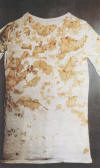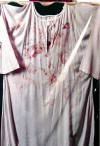2013. Padre Pio's life in pictures (4 parts)
A picture is worth a thousand words. As an introduction
to Padre Pio, these photographs will make us understand him better.
| |

Padre Pio moved in the convent of St. Mary of Graces in San
Giovanni Rotondo in 1916.
He would stay there until his death in 1968.
Note the wilderness.
|
| |

Padre Pio celebrated Mass at 5:00 AM. In the picture the men
are standing still, packed around the altar. The women are staying in the pews. To be there on time, one had to get up at 3:00
AM, and reach the church by 4:00, to be able to find a spot when the doors
opened.
|
| |

This picture was taken in the 40's at 12:00 noon.
Padre Pio is at the window of the choir, above the entrance to
the church, praying the "Angelus" with the faithful.
|
| |
 Padre Pio wanted an hospital that would give proper medical care
to the poor
peasants in the forgotten landscape in the middle of nowhere were they
lived, with no access to medical facilities.
Padre Pio wanted an hospital that would give proper medical care
to the poor
peasants in the forgotten landscape in the middle of nowhere were they
lived, with no access to medical facilities. |
| |
 And he did it! He called it "Casa Sollievo della
Sofferenza" (Home for the Relief of Suffering.)
And he did it! He called it "Casa Sollievo della
Sofferenza" (Home for the Relief of Suffering.) |
| |

This picture was taken the day Padre Pio was proclaimed
saint on June 16, 2002.
The old convent and church are on the side of the large church
of Santa Maria delle Grazie.
The window of the choir were Padre Pio prayed the "Angelus" and
waived to the crowd is still there.
|
|

Here we are in Rome, the day that Padre Pio was proclaimed
blessed on May 2, 1999.
The number of pilgrims present at the ceremony is immense.
|
| |

Padre Pio was proclaimed Saint on June 16, 2002
There is no other recollection of such a crowd packing Saint
Peter's Square, and extending well beyond Via della Conciliazione.
|
| |
 Padre Pio' final resting place in the crypt with the gold
ceiling of San Pio's church.
The body is in the pillar on the left, visible through an
opening in the form of the side wound.
There can be no better ending and beginning for a man who was
a gift of God to humanity for eternity.
|
| |
 It all started on Vico Storto Valle ("Crooked Valley Lane")
in Pietrelcina. The house were Padre Pio was born.
It all started on Vico Storto Valle ("Crooked Valley Lane")
in Pietrelcina. The house were Padre Pio was born. |
| 1887 |
 Padre Pio was born in Pietrelcina.
Pietrelcina is a rural village in the province of Benevento, in Southern Italy.
Padre Pio was born in Pietrelcina.
Pietrelcina is a rural village in the province of Benevento, in Southern Italy. |
| |
   The
maps help us figure out the location of Pietrelcina.
The
maps help us figure out the location of Pietrelcina.
(It reminds of an episode in the Gospel: John 1: 45 "Philip
found Nathaniel and said to him, 'We have found him of whom Moses in
the Law and the prophets wrote, Jesus son of Joseph, from Nazareth.'
Nathanael said to him, 'From Nazareth?
Can anything good come from
that place?'
Philip replied,
'Come and see.' ")
|
| |
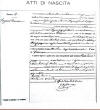 This is the birth certificate of Francesco Forgione.
It states that
the future Padre Pio was born on May 25,
1887,
at 5:00 PM.
This is the birth certificate of Francesco Forgione.
It states that
the future Padre Pio was born on May 25,
1887,
at 5:00 PM.
In a letter in 1922, Padre Pio wrote: “The
Lord from my birth showed me signs of a very special predilection." |
| |
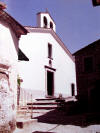  He was baptized in the nearby Saint Anna's Church on May 26, 1887 the day after
his birth, and given the name of Francesco.
He was baptized in the nearby Saint Anna's Church on May 26, 1887 the day after
his birth, and given the name of Francesco.
This is the outside of Sant'Anna's church.
|
| |
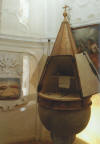 This is
the baptismal font were Francesco was baptized.
This is
the baptismal font were Francesco was baptized.
As he reported later, he started seeing his guardian angel since he
was in the crib.
"The Guardian Angel has been my companion since my
infancy."
He also stated seeing the devils:
"When I was in the crib, and my mom
extinguished the oil lamp I saw those horrible monsters and screamed
terrified. Than
mom turned the lamp back on, and the monsters
disappeared, and I stopped screaming."
|
| |
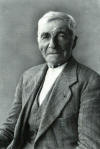 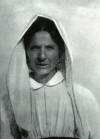 The name of Padre Pio’s father was Grazio, but he was known as
Orazio and called "Zi' Orazio" by his neighbors. The name of Padre Pio’s father was Grazio, but he was known as
Orazio and called "Zi' Orazio" by his neighbors.
The mother was Maria Giuseppa De Nunzio and was called "Zi'
Peppa".
The Forgiones were
farmers, cultivating their own piece of land. They married on June 8,
1881. Both were illiterate. He was a laborer.
She
brought a dowry of about a hectare of land. They were not poor. There
was food on the table every day. But there was very little cash. |
| |

  The house was located in Vico storto Valle, 32, in
Pietrelcina.
The house was located in Vico storto Valle, 32, in
Pietrelcina.
Like in most houses at the time: No plumbing. No bathroom. No running water. No
shower. No stove. No electricity.
. |
| |
  The
marble plaque outside the house tells that Francesco Forgione, the
future Padre Pio da Pietrelcina, was born in this house. The
marble plaque outside the house tells that Francesco Forgione, the
future Padre Pio da Pietrelcina, was born in this house.
The crib is preserved in the museum. |
| |
 The
Forgiones had 8 children. The first born was Michele. Then Francesco,
who died after 19 days, and Amalia who died at 20 months., When
Francesco, the future Padre Pio was born, he was given the name of the
older dead brother Francesco. He has also three younger sisters,
Felicita, Pellegrina, and Grazia (who was later to become a Bridgettine
nun0> The youngest brother, Mario, died before he turned 1 year old. The
Forgiones had 8 children. The first born was Michele. Then Francesco,
who died after 19 days, and Amalia who died at 20 months., When
Francesco, the future Padre Pio was born, he was given the name of the
older dead brother Francesco. He has also three younger sisters,
Felicita, Pellegrina, and Grazia (who was later to become a Bridgettine
nun0> The youngest brother, Mario, died before he turned 1 year old. |
|

   The land that they owned and cultivated was in Piana Romana,
less that an hour walk
away. They went to work there every day, and stayed there during the busier
months.
The land that they owned and cultivated was in Piana Romana,
less that an hour walk
away. They went to work there every day, and stayed there during the busier
months. |
| 1892 |
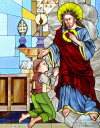
A stained window in the church of Sant'Anna remembers
of an episode of when he was still in preschool age, and later
reported in a letter by Padre Pio, when he had the first apparition of
Jesus: "I felt like not playing with the other kids on the parvis,
and sat in a pew in the church, and Jesus from the tabernacle called me
to the altar and put his hand on my head". At the time Francesco thought that this was normal to
everybody.
|
| |
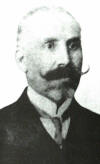 Teacher Angelo Caccavo.
Francesco had very limited formal schooling. There were no public schools in his
village. His first teacher was Cosimo Scocca, a farmer who had a fifth grade
education. His first grade teacher was Mandato Saginato. Starting September 1898, age 11,
he begun private lessons with
Domenico Tizzani, "per cinque lire al mese." The tuition of five lire per
month was quite a bit in those times. Padre Pio felt uncomfortable from day one, and after few months with don Tizzani, he changed
teacher.
He went to study with another teacher, Angelo Caccavo. With him Francesco got
the elementary diploma. A notebook with 30 themes developed by Padre Pio when he studied with Caccavo is
still preserved to these days. Teacher Angelo Caccavo.
Francesco had very limited formal schooling. There were no public schools in his
village. His first teacher was Cosimo Scocca, a farmer who had a fifth grade
education. His first grade teacher was Mandato Saginato. Starting September 1898, age 11,
he begun private lessons with
Domenico Tizzani, "per cinque lire al mese." The tuition of five lire per
month was quite a bit in those times. Padre Pio felt uncomfortable from day one, and after few months with don Tizzani, he changed
teacher.
He went to study with another teacher, Angelo Caccavo. With him Francesco got
the elementary diploma. A notebook with 30 themes developed by Padre Pio when he studied with Caccavo is
still preserved to these days.
|
| 1899 |
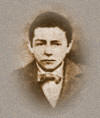 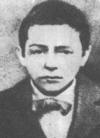 This is the first known picture of Francesco Forgione, taken at age 12.
But might be the picture of his cousin Franceschino who died at age 10.
This is the first known picture of Francesco Forgione, taken at age 12.
But might be the picture of his cousin Franceschino who died at age 10.
Padre Pio received the First Communion on 27 September 1899, at age 12, and was
confirmed the same day by the Archbishop of Benevento Mons. Donato Maria
Dell'Olio in the parish church of St. Mary of the Angels, in Pietrelcina. |
| |
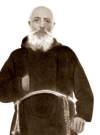 This is Fra' Camillo da Sant'Elia a Pianisi.
This is Fra' Camillo da Sant'Elia a Pianisi.
Fra' Camillo was a capuchin brother who walked the countryside away from
the convent to collect alms and food for the convent. Padre Pio saw him frequently in his childhood.
One day he told his mother:
"I want to be a friar with a beard, like fra' Camillo." |
| |
_small.jpg) Many times his mother found him sleeping on
the floor, using a stone as a pillow. Other times she found him
beating himself with a chain. Questioned about it he said: "I
must do like the roman soldiers beat Jesus and made his shoulders
bleed."
Many times his mother found him sleeping on
the floor, using a stone as a pillow. Other times she found him
beating himself with a chain. Questioned about it he said: "I
must do like the roman soldiers beat Jesus and made his shoulders
bleed."
|
| 1902 |
  In 1902 Padre Pio made a pilgrimage to Pompeii with his teacher Angelo Caccavo
and six schoolmates.
In 1902 Padre Pio made a pilgrimage to Pompeii with his teacher Angelo Caccavo
and six schoolmates.
“Soon I will enter the novitiate and there will be no more
parties.”
He also visited Sanctuary of the Blessed Virgin of Pompeii when he was
military in Naples. He encouraged people to be
“devout of the Virgin of Pompeii.” |
| 1903 |

On January 6, 1903, Francesco
left home for Morcone (30 Km from
Pietrelcina) to begin the novitiate in the Capuchin Order. His mom gave him a Rosary (still preserved) and said; "My son,
Saint Francis has called you, and you must go". Later he wrote: "My last night at home Jesus and his
Mother came to assure me
of their predilection". Francesco was accompanied to Morcone by the
priest don Nicola Caruso and by his teacher Angelo Caccavo, with two
other aspiring friars Antonio Bonavita and Vincenzo Masone. The distance
between Pietrelcina and Morcone is about 25 miles. They made the trip by
donkey and by train.
|
| 1904 |

 On January 2, 1904 he pronounced the temporary wows of charity, poverty
and obedience.
On January 2, 1904 he pronounced the temporary wows of charity, poverty
and obedience.
The religious name PIO was chosen by the
master of the novices.
|
| 1904 |
 On January
26, 1904 brother Pio and brother Anastasio, accompanied by Padre Pio di
Benevento, left Morcone for the convent of Sant’Elia a Pianisi (marked by a
star in the map) were they
would study rhetoric and frequent "quarta e quinta ginnasiale", 8th
and 9th grade of middle school.
On January
26, 1904 brother Pio and brother Anastasio, accompanied by Padre Pio di
Benevento, left Morcone for the convent of Sant’Elia a Pianisi (marked by a
star in the map) were they
would study rhetoric and frequent "quarta e quinta ginnasiale", 8th
and 9th grade of middle school.
|
| 1908 |

On October 1908, he moves to Serracapriola (Foggia) to start studies
of theology, continued at Montefusco (Avellino).
On December 19, 1908 Padre Pio received in the cathedral
of Benevento, by the Archbishop Benedetto Bonazzi, the four minor orders of
Doorkeeper, Reader, Exorcist, and Acolyte. Two days later, in the same cathedral of Benevento, Mons.
Paolo Schinosi, archbishop titular of Marcianopolis, conferred him the
Sub deaconate.
|
| 1909 |
 On July 18, 1909, he was ordained Deacon in the church of
the convent in Morcone.
On July 18, 1909, he was ordained Deacon in the church of
the convent in Morcone. |
| |
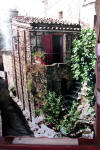
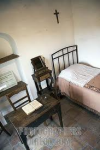
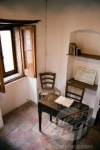 From 1910 to 1916 Padre Pio spent most of his time, in poor
health, at home in Pietrelcina. Since he was ordained and was inappropriate for him to
live in the family home, instead of the convent, the parents prepared
for him a single room up on a steep flight of stair, called "La Torretta". He
lived there.
La Torretta (The little tower) is a one room building, to which one can get
climbing steep stairs. A table, a bed, a window. It was very hard for Padre Pio in poor health
to climb the steep steps of La Torretta.
In La Torretta Padre Pio wrote letters
to his spiritual directors, had frequent apparitions of Jesus and other
heavenly beings, and was tormented by the devil with multiple
temptations.
|
| |
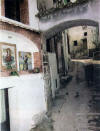  To get to La Torretta Padre Pio had to pass
through Porta Madonnella. He was very devout of the image of the Madonna
depicted there.
To get to La Torretta Padre Pio had to pass
through Porta Madonnella. He was very devout of the image of the Madonna
depicted there. |
| |
   Padre
Pio's home was in "Rione Castello" (Castle district), a medieval
conglomerate of dwellings built on a elevation called "La Morgia." When
he was in San Giovanni Rotondo he would say to the visitors from
Pietrelcina
"Say hi to La Morgia." Padre
Pio's home was in "Rione Castello" (Castle district), a medieval
conglomerate of dwellings built on a elevation called "La Morgia." When
he was in San Giovanni Rotondo he would say to the visitors from
Pietrelcina
"Say hi to La Morgia." |
| |
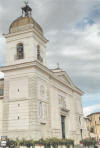 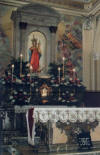 While in Pietrelcina, in the morning Padre Pio
said Mass in the parish church of Santa Maria degli Angeli (in the
pictures).
While in Pietrelcina, in the morning Padre Pio
said Mass in the parish church of Santa Maria degli Angeli (in the
pictures).
In this church Padre Pio had frequent ecstasies and also
experienced the fusion of the hearts:
"The heart of Jesus and mine were no more two
hearts beating, but only one. My heart had disappeared , like a drop of
water disappearing in the ocean."
|
| |
  After Mass he went to Piana Romana, about forty
five minutes walk away. There were two large stones in Piana
Romana, that Padre Pio called
"Il Seggiolone" (the high chair, or the big chair). Padre Pio spent
hours kneeling or sitting on them in meditation and prayer.
After Mass he went to Piana Romana, about forty
five minutes walk away. There were two large stones in Piana
Romana, that Padre Pio called
"Il Seggiolone" (the high chair, or the big chair). Padre Pio spent
hours kneeling or sitting on them in meditation and prayer. |
| 1910 |
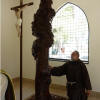 In Piana Romana Padre Pio's father built a
shelter, under an elm tree, so that he could spend in the shade the many
hours of prayer.
In Piana Romana Padre Pio's father built a
shelter, under an elm tree, so that he could spend in the shade the many
hours of prayer.
On September 20, 1918 Padre Pio
received the permanently visible Wounds, In San Giovanni Rotondo. In reality he had received the Wounds years before. On the afternoon of
September 7, 1910,
few weeks after being ordained priest, while he was
praying in Piana Romana, Jesus and Mary appeared and gave him the wounds. Padre Pio considered always September 7, 1910, the date he received the
wound.
|
| 1910 |
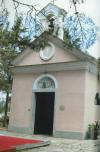  A chapel commemorates the event. A chapel commemorates the event.
Salvatore Pannullo, pastor of the Parish in Pietrelcina
testified that in that afternoon of September 7, 1910 Padre Pio showed him the wounds
and told him : "Father, do me a favor. Let's ask Jesus to take them away. I want to
suffer, to die from suffering, but in secret."
They prayed together, and God
answered their prayer. The wounds disappeared, but the suffering continued.
When Pannullo was told in 1918 that the wounds had appeared on
Padre Pio, he replied: You see them now. I saw them in 1910."
In a letter to Padre Benedetto, his spiritual director, dated
September 8, 1910, he wrote: "Yesterday evening some red spots appeared in the middle of my hands with
sharp pain." When years later Padre Pio recalled those
events he would say:
"Jesus has been there. All has happened there."
|
| 1911 |
 Padre Pio's health was not good. On October 1911,
after a physical examination by the famous dr. Antonio Cardarelli in Naples, he was
sent for convalescence to Venafro. According to the diagnosis of the celebrated physician,
the young friar's days were numbered, and he couldn't travel long distances, which is why he was sent to
Venafro, location of the
closest convent.
Padre Pio's health was not good. On October 1911,
after a physical examination by the famous dr. Antonio Cardarelli in Naples, he was
sent for convalescence to Venafro. According to the diagnosis of the celebrated physician,
the young friar's days were numbered, and he couldn't travel long distances, which is why he was sent to
Venafro, location of the
closest convent. |
| |
 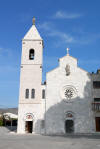 The
convent and church in Venafro today. The
convent and church in Venafro today.
During the month and a half stay in that convent, the community noticed
the first supernatural phenomena: divine ecstasies lasting up to one
hour, and diabolic apparitions lasting a few minutes. |
| 1911 |
 In Venafro, from Fr. Agostino's diary: 'Starting in November
1911, I was present with Fr. Evangelista, the superior of the monastery, for a
considerable number of ecstasies, and many instances of demonic oppression."
Satan would appear as a nude woman dancing lewdly, as is spiritual father,
as his superior, pope Pius X, his guardian angel, St. Francis, the Virgin
Mary, and also as the horrible self, with an army of demonic spirits. At times there were no apparitions but he was beaten until he
bled, tormented with deafening noises, covered with spit. He was able to free himself from the torments by calling on
the name of Jesus." Padre Pio always distinguished the devil's apparitions from
the heavenly visions by asking: "Say Long Live Jesus." (Ripeti
'Viva
Gesù). If it was the devil, he would disappear.
|
| 1911 |
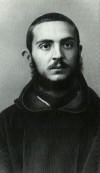 This picture was taken in Naples as a keep-sake
memento, when it was believed that Padre Pio's days were numbered.
He was 24 years old.
This picture was taken in Naples as a keep-sake
memento, when it was believed that Padre Pio's days were numbered.
He was 24 years old.
|
| |
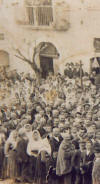 
_small.jpg) The
Madonna della Libera festivities in Pietrelcina at the times of Padre
Pio. The
Madonna della Libera festivities in Pietrelcina at the times of Padre
Pio. |
| |
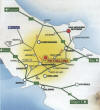 The map shows all the convents were Padre Pio lived,
in the southern part of Italy.
The map shows all the convents were Padre Pio lived,
in the southern part of Italy. |
| |
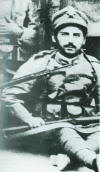 The
picture shows Padre Pio in military uniform. The
picture shows Padre Pio in military uniform.
He served in the Italian
Army from 1915 to 1918. He spent most of the time on sick leave. On November 6, 1915 Padre Pio was drafted, at age 28. On December 6, 1915
the recruit #12094, was assigned to the 10th Company
of Health in Naples. On December 17, 1915 a medical consultation diagnoses 'pulmonary
infiltration', and grants 1 year of convalescent leave.
|
| |
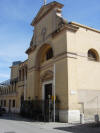 Church
of St. Anna and Capuchin convent in Foggia. Church
of St. Anna and Capuchin convent in Foggia.
Starting February 17, 1916 he lived in the convent of
St. Ann Foggia, in search of a more suitable place for his
frail health. But even there he continued to feel
sick: vomiting, sudden sweats, dizziness, and a very high fever. At night, terrifying noises came from
his room. They ended with a boom that would shake the walls and terrorize
the other friars.
He told father Benedetto that it was
the devil who, unable to win, exploded in fits of rage.
He stayed in Foggia until September 4, 1916.
|
| |
 On September 4, 1916 Padre Pio moves to the convent
of San Giovanni Rotondo.
On September 4, 1916 Padre Pio moves to the convent
of San Giovanni Rotondo.
On December 18, 1916 he returns to the Military hospital. December 30, 1916, new medical consultation.
He was granted 6 months
of sick leave. On September 4, 1917, he started training in the
Military Hospital of Naples. On November 5, 1917, he was granted 6 more months of medical leave.
|
| |

Padre Pio had long bouts of high fevers, followed by normal
temperatures. Padre Pio himself described the experience as a
"moral, rather than a physical, illness"
and said it was like he was
"in a furnace, still
always conscious". A friar attested that "even under the strain of this fever, Padre Pio is not knocked down, but gets up, moves
about, and can do everything." The body temperature was taken by mercury thermometer, today no longer in common use. Normal body temperature is 98.2°F (or 36.8°C).
A temperature at or above about 104 °F (40 °C) requires treatment.
Dr. Giorgio Festa in 1920 took Padre Pio's temperature as part of
his investigation. The reading was 48.5 C (119.3 F). In 1921 Father Lorenzo, superior of the convent, testified under oath
to Mons. Rossi that he
was skeptical, and had personally witnessed and recorded Padre Pio with fevers of 43C (109.4F) degrees Fahrenheit, then 45C
(113F) degrees, and finally 48C (118.4F) degrees.
|
| |
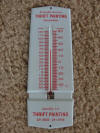
On December 1915 at the Trinity Military Hospital in Naples, during a
routine physical,
Padre Pio's temperature was taken by dr. Giuseppe Grieco,
lieutenant
medical doctor in the Italian Army, with a armpit mercury thermometer. In less than
one minute the thermometer cracked,
having gone over the maximum
temperature of 42C (107.6). Three other thermometers cracked the same
way. Dr. Grieco called in a colleague dr. Francesco Melle.
They decided to try with a bath thermometer, removed from the
casing that could read up to 80C (176F). The thermometer read 48C
(118.4).
They couldn't believe it, so they tried with a laboratory precision
thermometer. This time the temperature was 49C (120.2).
They decided to inform the captain prof. dr.
Felice D'Onofrio, chief of medical services. He came in,
measured again, and the reading was 49C.
"This is a mystery. This is impossible. I can't believe my
eyes. He should be in agony. This man is either a saint or a devil." He prescribed quinine and went to see him in the morning. He took again the temperature and was 36.7C (98.06). "I don't
understand anything. Let's send him home to die in peace." He gave him a year of medical leave.
|
| |

On March 6, 1918, Padre Pio was back in the military hospital. On March 16, 1918 he
was discharged for medical reason for "double broncho alveolitis."
Padre Pio's certificate of honorable discharge from the
Italian Army.
|
| 1916 |
 On September 4, 1916 Padre Pio went for a supposedly brief stay to
the convent of San Giovanni Rotondo. On September 4, 1916 Padre Pio went for a supposedly brief stay to
the convent of San Giovanni Rotondo.
The climate
appeared to be beneficial to him, and instead of a few weeks, he stayed
there for 52 years, until his death. |
| 1918 |
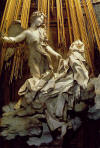 August 5, 1918
TRANSVERBERATION of the heart of Padre Pio. Transverberation is a spiritual wounding of the heart, as a
reward by God for loving him. Several saints experienced it. Some few names: Teresa of Avila,
Therese of Lisieux, Veronica Giuliani, Marguerite Marie Alacoque, Gerard Majella, Joseph of Cupertino, Francis de Sales, Philip Neri, Jane
Francis de Chantal, Lutgarde, Charles of Sezze.
Padre Pio about the Transverberation,
reported under obedience on August 5, 1918 "I was hearing the confessions of the boys, when a Celestial
Being holding a steel sword with a sharp flaming point, hurled it into my soul
with all his might. All done in a split of a second everything in my inside was
lashed by fire and steel. From that moment on I feel an open wound which causes
me to suffer continual agony."
|
| |
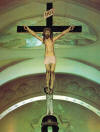
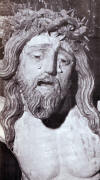 Padre Pio received the visible permanent
stigmata wounds on September 20, 1918, while praying at this Crucifix,
in the choir of the church of the convent, after having celebrated Mass
in the morning. He was 31 years old.
Padre Pio received the visible permanent
stigmata wounds on September 20, 1918, while praying at this Crucifix,
in the choir of the church of the convent, after having celebrated Mass
in the morning. He was 31 years old. |
| |
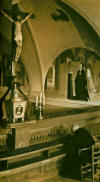 This is the location were Padre Pio received the
stigmata wounds. Over the years he continue to pray in the same spot.
This is the location were Padre Pio received the
stigmata wounds. Over the years he continue to pray in the same spot.Padre Pio reported under obedience:
"Suddenly I was
wrapped in a sea of blazing light.
In that light I saw
Jesus. He was very beautiful.
From his wounds came rays
of very bright white light that penetrated my hands, my feet, my
side.
They were like blades of fire that penetrated my skin
piercing, cutting, breaking.
I felt that I would die. The pain was immense." |
| 1918 |
 Padre Pio was alone in the choir when he received
the wounds. He felt embarrassment, and tried to hid them the best he
could. The father superior suspected something after few days because of
the stains of blood noted here and there. He confronted Padre Pio, and
under obedience got the truth.
Padre Pio was alone in the choir when he received
the wounds. He felt embarrassment, and tried to hid them the best he
could. The father superior suspected something after few days because of
the stains of blood noted here and there. He confronted Padre Pio, and
under obedience got the truth. |
| |
_small.jpg) The father superior immediately called the doctor
in town for an evaluation and advice. The superior provincial was
notified, and he informed the superior general in Rome. The superior
general reported
what was happening to the Vatican authorities. Medical doctors
and ecclesiastical prelates were sent to the convent to investigate the
situation.
The father superior immediately called the doctor
in town for an evaluation and advice. The superior provincial was
notified, and he informed the superior general in Rome. The superior
general reported
what was happening to the Vatican authorities. Medical doctors
and ecclesiastical prelates were sent to the convent to investigate the
situation.
Padre Pio was ordered to answer every question and
show the wounds to the investigators. A friar took some few pictures.
All this was very hard on Padre Pio, but he showed extreme patience and
understanding. The wounds were very painful, day and night, and he tried
to find ways to prevent the blood from dripping everywhere. |
| |
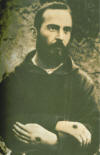 He tried to cover the hands the best he could when
he said Mass. But the faithful noted that something was different and
they noted the wounds, and by word of mouth the news spread, and the
crowds started coming well before the investigators did.
He tried to cover the hands the best he could when
he said Mass. But the faithful noted that something was different and
they noted the wounds, and by word of mouth the news spread, and the
crowds started coming well before the investigators did.
"I have asked Jesus to take away this signs
that cause me so much embarrassment. His answer has been: you will
bear them for fifty years."
"I want to suffer, but in secret."
"I desire nothing else than to love and
suffer."
"My sufferings are pleasing."
|
| |
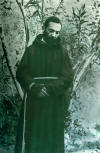
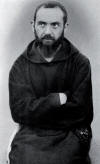 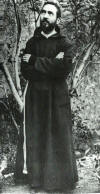 Padre Pio had some few pictures taken under
obedience. Padre Pio had some few pictures taken under
obedience.
"Jesus, let me suffer, and let me die from
suffering."
"I suffer because I cannot win all my
brothers to God."
"I suffer everything that Jesus suffered in
the Passion."
“I suffer only when I don't suffer."
"I suffer as much as anyone who has the whole
of humanity on his back."
|
| |
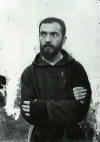
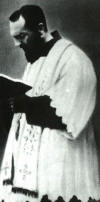 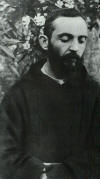 He started covering the hands with some sort of
half gloves. He started covering the hands with some sort of
half gloves.
He would remove them only during Mass, and put them back
while still at the altar.
"The Angels are jealous of us because they
can't suffer."
"My suffering gives glory to God, saves my
brothers in exile, and frees the souls from Purgatory."
|
| |
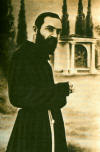 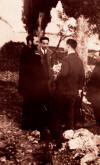 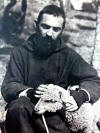 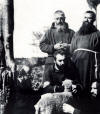 Padre Pio intensified his spiritual life with the
new situation he was in, and also tried to help the faithful, and to be
of least possible burden to the friary.
Padre Pio intensified his spiritual life with the
new situation he was in, and also tried to help the faithful, and to be
of least possible burden to the friary. |
| |
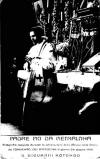 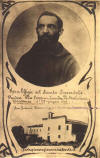 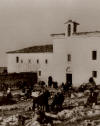 The
news about Padre Pio spread steadily beyond the Gargano and people
started coming from all over.
The
news about Padre Pio spread steadily beyond the Gargano and people
started coming from all over.
Souvenir cards with his image popped up.
The card on the left says: "Padre Pio da
Pietrelcina. Photograph taken during the celebration of the Mass in the
church of the convent of the capuchins on June 24, 1919. San Giovanni
Rotondo."
The card at the center says: "True effigy of the holy priest Padre Pio
Capuchin from Pietrelcina. Picture taken on June 27, 1919.
|
| |
 The newspapers took notice, and soon sent their
journalists mingled through the visitors.
The newspapers took notice, and soon sent their
journalists mingled through the visitors. |
| 1919 |
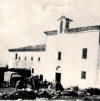
On May 9, 1919 the “Il Giornale d’Italia” was
the first newspaper to report about Padre Pio.
On June 1, 1919 “Il Tempo” run a title “Il
miracolo di un Santo” describing the instantaneous healing of a soldier
by Padre Pio.
On June 3, 1919 the same paper “Il Tempo”
titles “I miracoli di Padre Pio a San Giovanni Rotondo”, and reports some
prodigies attributed to the friar. Also reports that “at times his body
reaches temperatures of 50 C (F 122) as it has been observed with bath
thermometers)”.
|
| |
 The first full page newspaper article about Padre Pio was published on IL
MATTINO of Naples on June 20, 1919:
The first full page newspaper article about Padre Pio was published on IL
MATTINO of Naples on June 20, 1919:
"Padre Pio, il ‘santo’ di San Giovanni Rotondo,
opera un miracolo sulla persona del Cancelliere del paese. Presente un
nostro inviato.'
('Padre Pio, 'the saint' of San Giovanni Rotondo,
performs a miracle on the local courthouses chancellor. Our envoy was
present.')
|
| |

The journalist Renato Trevisani reported that Padre
Pio saw the 35 years old Pasquale Di Chiara walking painfully with two
canes. Padre Pio :
"Throw away those canes."
'How could I?
I will fall to the ground.'
"Throw away those canes" Padre Pio insisted.
Pasquale let the canes go while trying to reach for a
support. But there was no need. He was standing normally.
"Man of little faith. Go and walk." Renato Trevisani concluded that several people were
present, and all of them clapped their hands in admiration.
|
| |
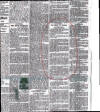 On June 19, 1920 the “Daily Mail” reports
“extraordinary events happening daily in San Giovanni Rotondo”, and
describes how the wounds had been investigated by the doctors and
prelates“.
On June 19, 1920 the “Daily Mail” reports
“extraordinary events happening daily in San Giovanni Rotondo”, and
describes how the wounds had been investigated by the doctors and
prelates“.
On October 27, 1923 the Belgian newspaper “Le Soir” describes the wounds, the examinations, the prodigies and the
“very high fevers of 48-50C “(118-122 F).
Since 1919 innumerable articles about Padre
Pio have been written in most every language in the papers around the
world. |
| |
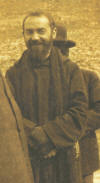 With all the action going on around him Padre Pio
did not lose his joyful ways. He
continued and intensified his ministry, with the Mass lasting close to
three hours, confessing twelve to fifteen hours per day, answering
the correspondence, giving solid spiritual direction, and with three or
four hours left for sleep.
With all the action going on around him Padre Pio
did not lose his joyful ways. He
continued and intensified his ministry, with the Mass lasting close to
three hours, confessing twelve to fifteen hours per day, answering
the correspondence, giving solid spiritual direction, and with three or
four hours left for sleep. |
| 1922 |
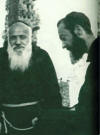 Thing seemed to go well for Padre Pio's ministry,
But soon they changed dramatically.
Thing seemed to go well for Padre Pio's ministry,
But soon they changed dramatically.
On June 22, 1922 Padre Antonio da San Giovanni in Persiceto,
General Superior of the Capuchin Order, received a document signed by the Secretary of the Supreme Congregation of the Holy
Office:
'The most Eminent General Inquisitors Cardinals deliberated on
May 10, 1922, regarding Padre Pio da Pietrelcina... He will celebrate Mass in private. He will not bless the
people. He will not show to anybody the so called stigmata. He will stop immediately any communication with Padre
Benedetto, his spiritual director. To best execute the above orders Padre Pio will be
immediately transferred to a convent preferably in Northern Italy. Padre Pio will no more answer letters. Whishing all the best, Cardinal Rafael Merry Del Val."
|
| 1923 |
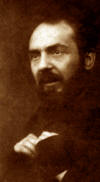 On May 31, 1923 the Holy Office (formerly Tribunal
of Inquisition) declares: "The Supreme
Congregation of the Holy Office, responsible for upholding the faith and defending morals, held an inquiry on the phenomena
attributed to Padre
Pio of Pietrelcina, a member Friar Minor of the Capuchins at the Monastery of San
Giovanni Rotondo in the Diocese of Foggia, and declares that: it cannot confirm
from this inquiry any basis for the supernatural character for this phenomena ("
...non constare de eorundem factorum supernaturalitate...")
and exhorts the faithful to confirm their
practices to this declaration."
On May 31, 1923 the Holy Office (formerly Tribunal
of Inquisition) declares: "The Supreme
Congregation of the Holy Office, responsible for upholding the faith and defending morals, held an inquiry on the phenomena
attributed to Padre
Pio of Pietrelcina, a member Friar Minor of the Capuchins at the Monastery of San
Giovanni Rotondo in the Diocese of Foggia, and declares that: it cannot confirm
from this inquiry any basis for the supernatural character for this phenomena ("
...non constare de eorundem factorum supernaturalitate...")
and exhorts the faithful to confirm their
practices to this declaration."
|
| |
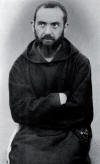 On June 8, 1923. Sant'Uffizio asks for Padre Pio
to be transferred to another convent, in Northern Italy or abroad. Also
orders that his Mass be celebrated in private and nobody can assist to
it.
On June 8, 1923. Sant'Uffizio asks for Padre Pio
to be transferred to another convent, in Northern Italy or abroad. Also
orders that his Mass be celebrated in private and nobody can assist to
it.
On August 8, 1923 Padre Pio is
notified of the order to be transferred in another convent.
"As a devout son of the holy obedience, and for
what depends on me, I will obey without opening mouth."
On August 12, 1923 in a letter to Francesco Morcaldi,
Padre Pio states: "The will of my superiors is the will of God. I only wish that
my bones will rest in a quiet corner of this land."
At this point a popular revolt takes place,
and the police reports that the transfer order cannot be
implemented without "spilling of blood" (spargimento di sangue).
On September 2, 1923 the order of transfer is revoked 'donec
aliter' (until new disposition is given).
|
| 1931 |
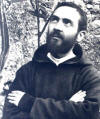 On May 13, 1931. A decree of Sant'Uffizio prohibits Padre Pio from celebrating Mass in public.
Padre Pio: "I will have less work and more merits."
On May 13, 1931. A decree of Sant'Uffizio prohibits Padre Pio from celebrating Mass in public.
Padre Pio: "I will have less work and more merits."
Padre Pio:
"I want to live and die in the (Roman
Catholic) Church." "The Church is always a mother even when it
strikes."
|
| |
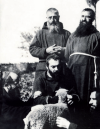 Padre Pio:
Padre Pio:
"Only the Catholic Church possesses Jesus in
the Blessed Sacrament."
"Other Christian religions were founded by
different men, but the Catholic religion was founded directly by Jesus
Christ." |
| 1933 |
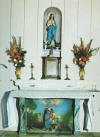 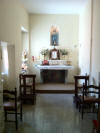 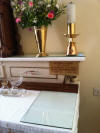
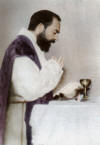 Padre Pio celebrating Mass alone in the internal
chapel of the convent.
Padre Pio celebrating Mass alone in the internal
chapel of the convent.
On July 15 1933, the restrictions were
lifted, and Padre Pio resumed Mass in public.
The removal came in the form of and
Indult (special concession) from Cardinal Donato Sbarretti, secretary of the
Holy Office, "in consideration that in this year
1933 there is the celebration of the extraordinary Holy Year of the Redemption".
With the removal of the restrictions for Padre Pio started a long period
of intense apostolate.
|
| |
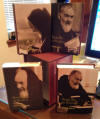 The Epistolary is the collection of the letters
written by Padre Pio or addressed to him by his spiritual directors,
spiritual children, other friars, and ecclesiastical authorities. It
also includes his spiritual will, and other writings by him. They
have been collected in four volumes and edited by the capuchin friars Melchiorre da Pobladura, Alessando da Ripobottoni, and Gerardo Di
Flumeri.
The Epistolary is the collection of the letters
written by Padre Pio or addressed to him by his spiritual directors,
spiritual children, other friars, and ecclesiastical authorities. It
also includes his spiritual will, and other writings by him. They
have been collected in four volumes and edited by the capuchin friars Melchiorre da Pobladura, Alessando da Ripobottoni, and Gerardo Di
Flumeri.
Currently in Italian the fourth edition of 2000, has been reprinted in
2011-2012, with revisions and correction. There is also an English
edition. |
| |
 The first volume includes the correspondence with
Padre Pio's spiritual directors between 1910 and 1922. 4th Italian
Edition 2011
The first volume includes the correspondence with
Padre Pio's spiritual directors between 1910 and 1922. 4th Italian
Edition 2011
Padre Pio wrote 111 letters to Padre Benedetto and
151 to Padre Agostino.
He received 66 letters from Padre Benedetto and 179
from Padre Agostino.
|
| |
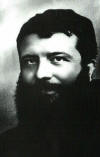 Padre Benedetto da San Marco in Lamis
Padre Benedetto da San Marco in Lamis
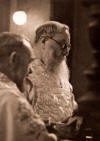 Padre Agostino da San Marco in Lamis
Padre Agostino da San Marco in Lamis |
| |
 The second volume includes the correspondence with
noblewoman Raffaelina Cerase (1914-1915), 3rd Italian
edition, 2011
The second volume includes the correspondence with
noblewoman Raffaelina Cerase (1914-1915), 3rd Italian
edition, 2011
97 letters in all, 56 from Padre Pio to Raffaelina,
and 41 from Raffaelina to Padre Pio.
|
| |
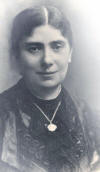 Noblewoman Raffaelina Cerase from Foggia, Italy.
Noblewoman Raffaelina Cerase from Foggia, Italy.
Raffaelina
Cerase, from Foggia, now Servant of God. In 1914 she started
the exchange of numerous letters with Padre Pio for spiritual direction. In
1915 she became gravely ill and asked if Padre Pio could come to Foggia
to confess her. At that time Padre Pio was at home in Pietrelcina in
convalescent leave. He was solicited to go to Foggia by padre Agostino
and padre Benedetto. He was in Foggia on February 17, 1916 and stayed
at the capuchin convent of St. Anna. Raffaelina Cerase was visited daily
by Padre Pio from February 17, 1916, until the day of her death on March
25, 1916.
|
| |
 Vol. III Correspondence with
spiritual daughters (1915-1923) 4th edition, 2012 Vol. III Correspondence with
spiritual daughters (1915-1923) 4th edition, 2012
21 letters to Annita Rodote.
15 letters to Margherita Tresca, and 12 letters from
Margherita Tresca.
67 letters to Maria Gargani,
35 to Assunta Di Tomaso,
6 to Lucia Fiorentino,
19 to Rachelina Russo, 43 to the Ventrella sisters Vittorina, Elena
Maria, and Filomena.
69 letters to Erminia Gargani,
45 letters to Antonietta Vona, 31 to the Campanile sisters Lucia, Maria, and Rachelina.
4 letters to Girolama Longo,
10 to Frieda Folger, 22 to Elena Bandini,
3 to Violante Masone,
2 letters to Graziella
Pannullo.
|
| |

Vol IV Correspondence with
several people. 3rd Italian edition, 2012.
The voume includes letters to ecclesiastical authorities, fellow
Capuchin friars, diocesan priests, friends, and spiritual sons. Letters to
three families: Bavassano-Devoto, Marchesani-Leontina, Melchioni-Lagorio.
Letters to his own parents and relatives. Spiritual
will of Padre Pio.
Writings by Padre Pio.
|
| |
 An
example of Padre Pio handwriting. The letter has the date 22-10-'18. In
Italian the day of the month comes before the month and before the
years. The letter was written on October 22, 1918. An
example of Padre Pio handwriting. The letter has the date 22-10-'18. In
Italian the day of the month comes before the month and before the
years. The letter was written on October 22, 1918. |
Padre Pio's hospital "Casa Sollievo della Sofferenza" (Home for the
Relief of Suffering).
| |

In 1940 Padre Pio started thinking of a new hospital.
Here he is with dr. Sanvico.
The evening of January 9, 1940 the Home for the relief of suffering was
born on paper. A tiny committee formed by dr. Kiswarday, secretary, dr. Sanguinetti, dr. Sanvico
secretary, miss Seits, and Padre Pio, founder, got immediately into
action.
|
| |
 Padre Pio with dr. Sanvico, dr. Sanguinetti
and others.
Padre Pio with dr. Sanvico, dr. Sanguinetti
and others.
From the minutes of the first meeting: "It is agreed
that everything undertaken must be subject to Padre Pio's advice." Padre Pio got from a pocket
a small gold coin which had been given to him and said: "I
want to be the first to make an offering for the Home for the Relief of
Suffering."
Padre Pio refused to consider a bank loan. |
| |
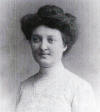 Maria Basilio Venchi, a spiritual daughter,
brought the most part of the land were the future hospital would be
built, and donated it to Padre Pio.
Maria Basilio Venchi, a spiritual daughter,
brought the most part of the land were the future hospital would be
built, and donated it to Padre Pio. |
| |
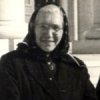 Angela Serritelli,
also spiritual daughter, owned the adjacent part of the land needed for
the hospital. She donated it to Padre Pio.
Angela Serritelli,
also spiritual daughter, owned the adjacent part of the land needed for
the hospital. She donated it to Padre Pio. |
| |
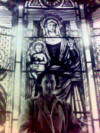  Barbara
Ward in the chapel of the hospital "Casa Sollievo". The Madonna in the
stained window bears resemblance to Barbara. Barbara
Ward in the chapel of the hospital "Casa Sollievo". The Madonna in the
stained window bears resemblance to Barbara.
Barbara Ward was instrumental in securing the
funding for the construction of the hospital from UNRRA.
On June 21, 1948 the UNRRA awarded a grant of four hundred millions of
Italian lire for
the construction of the hospital. |
| |
Barbara Ward:
“Padre Pio had downright common sense and
intensely practical attitude towards life. Padre Pio never forgot that
Our Lord not only preached to souls, but also healed bodies. Padre Pio
lived in southern Italy in an area of unrelieved poverty which was the
root of so many neglected diseases, lifelong illnesses, crippling,
blindness, infirmities and miseries. This was the tragic load he had to
deal with from the moment he entered the church at dawn until the last
penitents went on their way.” |
| |
 May 19, 1947: Lying of the first stone and
ground braking for the construction of the hospital "Casa Sollievo."
May 19, 1947: Lying of the first stone and
ground braking for the construction of the hospital "Casa Sollievo."
Padre Pio: "Here will
stand one of the largest centers for the cure of the human ailments." |
| |
 The construction work is progressing.
The construction work is progressing. |
| |
  Padre Pio in the car, visiting the construction
site.
Padre Pio in the car, visiting the construction
site. |
| |
 May 5, 1956 grand opening of the Casa Sollievo
della Sofferenza Home for the relief of Suffering.
May 5, 1956 grand opening of the Casa Sollievo
della Sofferenza Home for the relief of Suffering.
The New York Times: "One of the most
beautiful and most modern hospitals in the world."
Padre Pio: "Nothing is too good or too
beautiful for the sick and suffering." |
| |
  Padre Pio celebrated Mass and made a speech on the
day of the grand opening.
Padre Pio celebrated Mass and made a speech on the
day of the grand opening.
|
| |
 visiting patients,
visiting patients,  testing the food,
testing the food, 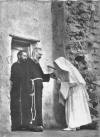 greeted by a nurse nun.
greeted by a nurse nun. |
| |
 The hospital today.
The hospital today. |
| |
See Padre Pio making a speech at the grand opening of the Casa Sollievo
della Sofferenza |
| |
 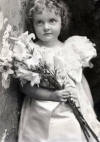   Mary Pyle was born on April 17, 1888 at 215 West
45th Street in New York
City, NY.
Mary Pyle was born on April 17, 1888 at 215 West
45th Street in New York
City, NY.
She died on April 26, 1968 in San Giovanni Rotondo.
On September 15, 1888 she received the Christian Baptism in the Church of
the Covenant (merged with the Brick Presbyterian Church in 1894),
as Adelia McAlpin Pyle. |
| |
 This picture was taken in a
Montessori classroom in San Francisco. The individuals in the back of the classroom, from left to right,
are Mario Montessori (son of Maria Montessori), Helen Parkhurst, Maria Montessori, and
Adelia Mary Pyle.
This picture was taken in a
Montessori classroom in San Francisco. The individuals in the back of the classroom, from left to right,
are Mario Montessori (son of Maria Montessori), Helen Parkhurst, Maria Montessori, and
Adelia Mary Pyle.
While in Europe in a study trip Mary Pyle met Maria Montessori, the educator who
developed the Montessori Method. She became her assistant and
interpreter. |
| |
 Mary Pyle met Padre Pio on October 4, 1923. He
told her: "My daughter, do not travel
anymore. Stay here." She
stayed, and built a
house near the convent.
Mary Pyle met Padre Pio on October 4, 1923. He
told her: "My daughter, do not travel
anymore. Stay here." She
stayed, and built a
house near the convent. |
| |
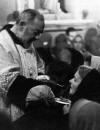 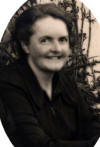 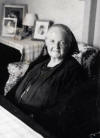 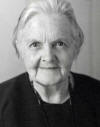 Mary went daily to Padre Pio's
Mass and received the communion. She became a member of
the Third Order of Saint Francis.
Mary went daily to Padre Pio's
Mass and received the communion. She became a member of
the Third Order of Saint Francis. |
| |
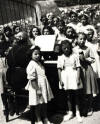 She played the harmonium, directed the choir in
singing, ad organized children in the Christmas play at the convent.
She played the harmonium, directed the choir in
singing, ad organized children in the Christmas play at the convent. |
| |

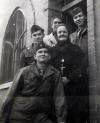 She was generous with the pilgrims, the poor, and the friars.
Here she is with American soldiers visiting
during WWII. She was generous with the pilgrims, the poor, and the friars.
Here she is with American soldiers visiting
during WWII. |
| |
 She met Padre Pio and the other friars frequently.
In the picture Padre Pio is giving advice to Mary Pyle.
She met Padre Pio and the other friars frequently.
In the picture Padre Pio is giving advice to Mary Pyle. |
| |
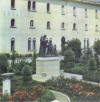  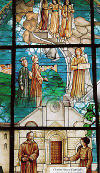 The Capuchin convent and the church of the Holy Family in Pietrelcina. In the stained window, at the bottom Mary
Pyle is shown donating it to Padre Pio.
The construction was completed in 1951.
The Capuchin convent and the church of the Holy Family in Pietrelcina. In the stained window, at the bottom Mary
Pyle is shown donating it to Padre Pio.
The construction was completed in 1951.
In Pietrelcina a young student Padre Pio, walking
with archpriest Salvatore Pannullo by an area called "Gregaria", "heard
a choir of angels singing, and bells in full peal" and prophesized that
one day a convent and a church would be built, for the sons of St.
Francis in that location.
Years
later he told Mary Pyle to build it.
"...and dedicate it to
the Sacred Family". So she financed the church of the Holy Family, a
convent and a seminary for the Capuchin students in Pietrelcina. During
the building Mary stayed in Pietrelcina in the same place where Padre Pio
had lived from 1910 to 1916.
|
| |
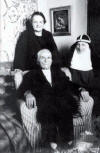
 Mary Pyle with padre Pio's father and sister. In the second picture she
is with count Hefner and the niece of Padre Pio with her daughter.
Mary Pyle with padre Pio's father and sister. In the second picture she
is with count Hefner and the niece of Padre Pio with her daughter. |
| |
 Padre Pio caring for his dying father at the
home of Mary Pyle. Padre Pio caring for his dying father at the
home of Mary Pyle.
In
December 1929, Mary had taken Mamma Peppa and “zì” Grazio in her home, to San Giovanni
Rotondo so that they could be closer to their son. She cared for them until they died.
Mamma Peppa died of pneumonia on January 3, 1930. "Zi Grazio" died on
July 10, 1946. |
| |
 Mary Pyle, with Our Lady of Grace, greets Padre Pio at the entrance to
Paradise. Mary Pyle, with Our Lady of Grace, greets Padre Pio at the entrance to
Paradise.
Mary Pyle is the only spiritual child of
Padre Pio featured in the mosaics of the golden Crypt of the new San Pio
church. |



 Padre Pio wanted an hospital that would give proper medical care
to the poor
peasants in the forgotten landscape in the middle of nowhere were they
lived, with no access to medical facilities.
Padre Pio wanted an hospital that would give proper medical care
to the poor
peasants in the forgotten landscape in the middle of nowhere were they
lived, with no access to medical facilities. And he did it! He called it "Casa Sollievo della
Sofferenza" (Home for the Relief of Suffering.)
And he did it! He called it "Casa Sollievo della
Sofferenza" (Home for the Relief of Suffering.)



 It all started on Vico Storto Valle ("Crooked Valley Lane")
in Pietrelcina. The house were Padre Pio was born.
It all started on Vico Storto Valle ("Crooked Valley Lane")
in Pietrelcina. The house were Padre Pio was born.
























_small.jpg)







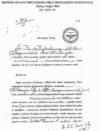

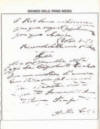

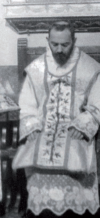




















_small.jpg)












_small.jpg)



























